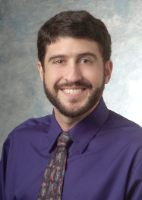Peer Reviewed Orthopaedic
siRNA Delivery to Stem Cells in the Treatment of Post-Traumatic Osteoarthritis



Posted August 19, 2016
Eben Alsberg, Ph.D., Case Western Reserve University, Cleveland, Ohio

Post-traumatic osteoarthritis (OA) is highly prevalent in combat-wounded Soldiers and remains one of the major causes of disability among military personnel. As a degenerative joint disease that occurs due to damage of the articular cartilage between joints, OA typically results in lifetime pain and disability. Current treatment options for post-traumatic OA are limited and usually focused on treating damaged articular cartilage; however, these therapies often fail to restore total function. Effective or alternative treatment options that address cartilage regeneration in patients suffering from post-traumatic OA are now being sought by researchers in the field.
With funding from a Fiscal Year 2012 Peer Reviewed Orthopaedic Research Program Translational Research Award, Dr. Eben Alsberg and his team at Case Western Reserve University are using a novel technique of cartilage tissue engineering that may be beneficial in restoring total cartilage function in patients suffering from post-traumatic OA. Dr. Alsberg plans to use human mesenchymal stem cells (hMSCs), a clinically relevant cell source for cartilage tissue engineering strategies.
Dr. Alsberg’s talented team is comprised of biomedical, mechanical, and chemical engineers, an orthopaedic surgeon, a biologist, several veterinary technicians, and a histologist. This integrated research group has successfully engineered a system of self-assembling stem cell sheets incorporated with growth factor-releasing hydrogel microspheres capable of forming cartilage. Dr. Alsberg has been using genetic approaches such as delivery of siRNAs and miRNAs that can direct the differentiation of MSCs down the chondrogenic lineage and form cartilage, and he is now examining the role of mechanical stimulation on the resultant tissue properties. The research team plans to examine the capacity of the cell constructs to treat cartilage defects.
Working closely with his team, which includes Dr. Minh Khanh Nguyen, Dr. Cong Truc Huynh, Ms. Alexandra McMillan, Dr. Oju Jeon, Mr. Michael Hill, and Mr. Zijie Zheng, Dr. Alsberg aims to address a pressing question: ‘‘Can stem cells obtained from a post-traumatic OA patient’s bone marrow be guided to become chondrocytes and form sheets of cartilage tissue to repair osteochondral defects by controlling the spatiotemporal presentation of RNAs?” If successful, this technology will have a significant impact in advancing the treatment of many patients including Service members suffering from post-traumatic OA.
Publications:
Cong CT, Nguyen MK, Tonga GY, et al. 2016. Photocleavable hydrogels for light-triggered siRNA release. Adv Healthc Mater 5(3):305-310.
Hill MC, Nguyen MK, Jeon O, and Alsberg E. 2015. Spatial control of cell gene expression by siRNA gradients in biodegradable hydrogels. Adv Healthc Mater 4(5):714-722. Highlighted on back cover.
Samorezov JE and Alsberg E. 2015. Spatial regulation of controlled bioactive factor delivery for bone tissue engineering. Adv Drug Deliv Rev 84:45-67.
Jeong SI, Burns NA, Bonino CA, et al. 2014. Improved cell infiltration of highly porous 3D nanofibrous scaffolds formed by combined fiber-fiber charge repulsions and ultrasonication. J Mater Chem B Mater Biol Med 2(46):8116-8122.
Nguyen K, Jeon O, Krebs MD, and Alsberg E. 2014. Sustained localized presentation of RNA interfering molecules from in situ forming hydrogels to guide stem cell osteogenic differentiation. Biomaterials 35(24):6278-6286.
Links:
Last updated Thursday, December 5, 2024














